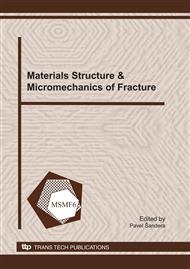p.487
p.491
p.495
p.499
p.503
p.507
p.511
p.515
p.519
Utilization of Electromagnetic and Acoustic Emission in Monitoring of Fracture of Cementitious Composites
Abstract:
The paper is focused on the utilization of electromagnetic emission (EME) and acoustic emission (AE) phenomena within the non-destructive assessment of damage and fracture in cementitious composites. In the first part of the paper, the EME and AE responses from tests performed in two testing configurations differing considerably in stress distribution are investigated. Typical EME and AE response waveforms appear not to differ from each other for either of the loading configu-rations. However, a significant difference is observed in the frequency distribution of the time lag of the acoustic signal behind the electromagnetic one, which results from the different distribution of the fracture events over the specimen’s volume. In the second part of the paper, the failure process within the specimens in the used testing configurations is assessed from the fracture-mechanical point of view. A numerical 3D analysis of the stress distribution and crack propagation within the specimens was performed by using ATENA non-linear FEM code based on a fracture- and damage-mechanics, and plasticity approach. The predictions of the numerical model are in good agreement with the results obtained by AE/EME experimental measurements. The comparison of the AE/EME records from the tests with the results of performed numerical simulation can help in the understanding, interpretation and exploitation of AE/EME in research into damage to and failure of non-electric quasi-brittle silicate-based building materials.
Info:
Periodical:
Pages:
503-506
Citation:
Online since:
January 2011
Authors:
Price:
Сopyright:
© 2011 Trans Tech Publications Ltd. All Rights Reserved
Share:
Citation:


